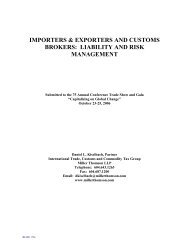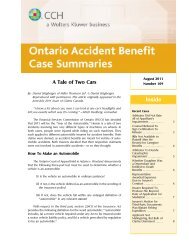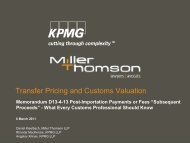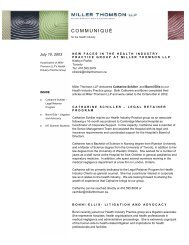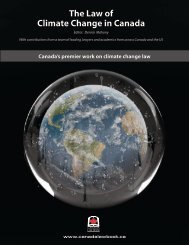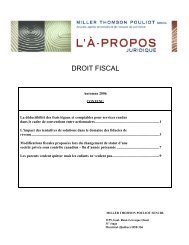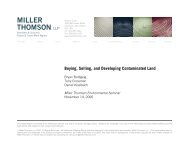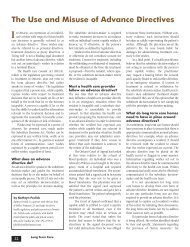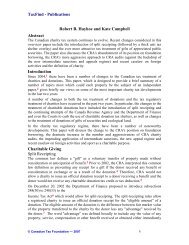Director's Duties and Responsibilities in the Charitable and Non ...
Director's Duties and Responsibilities in the Charitable and Non ...
Director's Duties and Responsibilities in the Charitable and Non ...
You also want an ePaper? Increase the reach of your titles
YUMPU automatically turns print PDFs into web optimized ePapers that Google loves.
MILLER THOMSON LLPBarristers & SolicitorsTax Notesprocedures, with many tasks delegatedto <strong>the</strong> senior officers of <strong>the</strong> organization,while a newly <strong>in</strong>corporated localorganization, with a few <strong>in</strong>dividualsoccupy<strong>in</strong>g <strong>the</strong> roles of member,director<strong>and</strong> officer, will m<strong>and</strong>ate considerablymore ‘h<strong>and</strong>s on’ <strong>in</strong>volvement. The keyto management is proper delegation,<strong>and</strong> <strong>the</strong> key to proper delegation is toconsider what a prudent person woulddo under similar circumstances.Fiduciary DutyA director is entrusted with <strong>the</strong> abilityto exercise power over ano<strong>the</strong>r <strong>and</strong> toaffect <strong>the</strong> legal or practical <strong>in</strong>terests of avulnerable beneficiary. This expressionof a director’s fiduciary relationshipwith <strong>the</strong> organization imposes a fiduciaryduty on <strong>the</strong> director. Thus,a directormust exercise <strong>the</strong> utmost good faith,trust, confidence <strong>and</strong> c<strong>and</strong>our, whileact<strong>in</strong>g with <strong>the</strong> highest degree ofhonesty <strong>and</strong> loyalty toward, <strong>and</strong> witha view to <strong>the</strong> best <strong>in</strong>terests of, <strong>the</strong>beneficiary-organization.The fiduciary duty arises most frequently<strong>in</strong> a conflict of <strong>in</strong>terest scenario. Wherea director owes loyalties to both <strong>the</strong>non-profit or charitable organization <strong>and</strong>ano<strong>the</strong>r entity, a director must properlymanage <strong>the</strong> conflict by fully disclos<strong>in</strong>g<strong>the</strong>ir <strong>in</strong>terests <strong>and</strong> refra<strong>in</strong><strong>in</strong>g fromvot<strong>in</strong>g on <strong>the</strong> subject of <strong>the</strong> conflict.Duty to Act <strong>in</strong> Scope of AuthorityWhile <strong>the</strong> concept of scope of authorityis largely a historical curiosity <strong>in</strong> <strong>the</strong>context of for-profit entities that possess<strong>the</strong> capacity, rights, powers <strong>and</strong> privilegesof a natural person,many non-profit<strong>and</strong> charitable organizations havespecific restrictions on <strong>the</strong>ir objectswhich are necessary to obta<strong>in</strong> <strong>the</strong>irspecial status. Accord<strong>in</strong>gly, it is imperativefor directors to be aware of <strong>the</strong><strong>in</strong>herent limitations on <strong>the</strong> activities of<strong>the</strong> organization,as expressed <strong>in</strong> <strong>the</strong>constat<strong>in</strong>g documents.In <strong>the</strong> event <strong>the</strong> directors exceed <strong>the</strong>authority of an organization, <strong>the</strong> ultravires doctr<strong>in</strong>e may subject <strong>the</strong> directorsto personal liability for <strong>the</strong> organization’sillegal actions. A director mayavoid personal liability by oppos<strong>in</strong>g<strong>the</strong> board’s motion <strong>and</strong> ensur<strong>in</strong>g thatthis opposition is properly reflected <strong>in</strong><strong>the</strong> m<strong>in</strong>utes of <strong>the</strong> organization. Byadher<strong>in</strong>g to <strong>the</strong>se seven duties, <strong>the</strong> nonprofitor charitable director canm<strong>in</strong>imiz<strong>in</strong>g potential liability, whileensur<strong>in</strong>g <strong>the</strong> future success of <strong>the</strong>organization.Douglas ForerEdmonton, 780.429.9742dforer@millerthomon.caHugh KellyToronto, 416.595.8176hkelly@millerthomson.ca*This article orig<strong>in</strong>ally appeared <strong>in</strong><strong>the</strong> 26 January 2001 issue of TheLawyer's Weekly.Urgent Note to CanadaCorporations Act CompaniesAre you up-to-date on your annual returnfil<strong>in</strong>gs? As a federally <strong>in</strong>corporatednon-share capital corporation, you arerequired to file annual returns undersubsection 133(1) of <strong>the</strong> CorporationsAct. Failure to file such returns can result<strong>in</strong> loss of corporate status, with <strong>the</strong>result that your assets escheat to(become <strong>the</strong> property of) <strong>the</strong> Crown.An extensive list of corporations <strong>in</strong>default was published <strong>in</strong> <strong>the</strong> CanadaGazette on December 23,2000. Corporationson that list have one year fromDecember 23, 2000 to file <strong>the</strong> requiredreturns <strong>and</strong> thus regularize <strong>the</strong>ir status.Don’t delay. Please contact us if we canassist you <strong>in</strong> ei<strong>the</strong>r verify<strong>in</strong>g that yourreturns are up-to-date or whe<strong>the</strong>r yourorganization is listed <strong>and</strong> needs to filereturns to avoid dissolution.Susan Manwar<strong>in</strong>gToronto, 416.595.8583smanwari@millerthomson.caBrenda TaylorMarkham, 905.415.6739btaylor@millerthomson.caPierc<strong>in</strong>g <strong>the</strong> Corporate VeilIn a recent Ontario Court of Appealdecision,Lana International Ltd.et al.v.Menasco Aerospace Ltd., et al.(releasedon 7 September 2000), <strong>the</strong> court heldthat a corporate officer may be personallyliable <strong>in</strong> tort for actions performed<strong>in</strong> <strong>the</strong> scope of <strong>the</strong>ir employment.The case <strong>in</strong>volved a corporate pla<strong>in</strong>tiffwho had purchased eight sets ofl<strong>and</strong><strong>in</strong>g gear from ano<strong>the</strong>r corporatedefendant. The l<strong>and</strong><strong>in</strong>g gear was to beused on Boe<strong>in</strong>g 737s. After purchas<strong>in</strong>g<strong>the</strong> l<strong>and</strong><strong>in</strong>g gear <strong>and</strong> resell<strong>in</strong>g it, <strong>the</strong>l<strong>and</strong><strong>in</strong>g gear was recalled. Due to <strong>the</strong>recall <strong>and</strong> <strong>the</strong> manner <strong>in</strong> which it wascarried out, <strong>the</strong> Pla<strong>in</strong>tiff sued for breachof contract, negligence, <strong>and</strong> negligentmisrepresentation. The Pla<strong>in</strong>tiff issueda claim aga<strong>in</strong>st <strong>the</strong> corporation, <strong>and</strong><strong>the</strong>ir president as a personal defendant.After <strong>the</strong> Pre-Trial exam<strong>in</strong>ation of <strong>the</strong>president, he asked to have <strong>the</strong> claimsaga<strong>in</strong>st him dismissed. It was arguedsuccessfully before a judge that, s<strong>in</strong>cehe was act<strong>in</strong>g with<strong>in</strong> <strong>the</strong> scope of hiscorporate responsibilities, he wasprotected from personal liability.The Pla<strong>in</strong>tiff appealed successfully to ahigher court, which stated that <strong>the</strong>judge had erroneously considered that<strong>the</strong> defendant was immune frompersonal liability for his actions solelybecause those actions were performed<strong>in</strong> <strong>the</strong> course of his duties to <strong>the</strong> corporationthat employed him.Among <strong>the</strong> allegations aga<strong>in</strong>st <strong>the</strong> president,were that he authorized <strong>the</strong>wrongful act of sell<strong>in</strong>g <strong>the</strong> l<strong>and</strong><strong>in</strong>ggears, he had acted negligently <strong>in</strong> fail<strong>in</strong>gto enforce <strong>the</strong> terms of <strong>the</strong> contractwith Boe<strong>in</strong>g, <strong>and</strong> he had caused damageto <strong>the</strong> pla<strong>in</strong>tiff’s bus<strong>in</strong>ess as a result offalse statements made dur<strong>in</strong>g <strong>the</strong> recall.In reach<strong>in</strong>g <strong>the</strong>ir decision, <strong>the</strong> courtstated:“As I read <strong>the</strong> judge’s reasons, heproceeded on <strong>the</strong> premise that if acorporate officer or employeeperforms a tortious act entirely <strong>in</strong>relation to or with<strong>in</strong> <strong>the</strong> scope of hiscorporate duties, he would for thatreason alone,be immune from liability.In my view, this states <strong>the</strong> protectionfrom liability too broadly.”The judgment is a rem<strong>in</strong>der that corporateofficers can be personally liable for(negligent) conduct, even when act<strong>in</strong>g<strong>in</strong> <strong>the</strong> course of <strong>the</strong>ir employment.Consequently, corporate officers shouldensure that <strong>the</strong>y have adequate <strong>in</strong>surancecover to protect <strong>the</strong>mselvesfrom such a possibility. But even with<strong>in</strong>surance <strong>the</strong> lesson of this case isworth remember<strong>in</strong>g: corporate officerscont<strong>in</strong>ue to have a direct personal dutyto act <strong>in</strong> an honest <strong>and</strong> careful manner.Hugh KellyToronto, 416.595.8176hkelly@millerthomson.caRobert HickmanMarkham, 905.415.6755rhickman@millerthomson.ca
CHARITIES AND NOT-FOR-PROFITNew Ontario Charities Account<strong>in</strong>gAct RegulationsThe Ontario Charities Account<strong>in</strong>g Actpermits <strong>the</strong> issuance of regulations to:ii(i) <strong>in</strong>demnify directors <strong>and</strong> officers;i(ii) purchase <strong>in</strong>surance for directors<strong>and</strong> officers;(iii) pool <strong>in</strong>vestment funds;(iv) remunerate its directors forservices provided.The Public Guardian <strong>and</strong> Trustee ofOntario has taken <strong>the</strong> position that all of<strong>the</strong>se acts are o<strong>the</strong>rwise breaches of trust.Pursuant to this authority, last monthOntario Regulation 04/01 (availableonl<strong>in</strong>e at http://192.75.156.68/ DBLaws/Regs/English/010004_e.htm) wasissued deal<strong>in</strong>g with <strong>the</strong> <strong>in</strong>demnification<strong>and</strong> <strong>in</strong>surance of directors <strong>and</strong> officers<strong>and</strong> with <strong>the</strong> pool<strong>in</strong>g of trust funds.Although we expected that regulationswould also be released to permit directorsof a charity to be remunerated forservices o<strong>the</strong>r than as directors,this issuewas not dealt with <strong>in</strong> <strong>the</strong> Regulation.The new rules only permit <strong>in</strong>demnification<strong>and</strong> <strong>in</strong>surance if <strong>the</strong> directoror officer acted honestly <strong>and</strong> <strong>in</strong> goodfaith. The rules also list a number offactors which must be considered by acorporation <strong>in</strong> giv<strong>in</strong>g an <strong>in</strong>demnity orpurchas<strong>in</strong>g <strong>in</strong>surance for trustees ordirectors, such as:1. <strong>the</strong> degree of risk;2. o<strong>the</strong>r means available to deal with<strong>the</strong> risk;3. <strong>the</strong> reasonableness of <strong>the</strong> <strong>in</strong>surancecost <strong>in</strong> relation to <strong>the</strong> risk;4. <strong>the</strong> reasonableness of <strong>the</strong> <strong>in</strong>surancecost <strong>in</strong> relation to revenue of <strong>the</strong>charity;5. does <strong>the</strong> <strong>in</strong>surance or <strong>in</strong>demnityadvance <strong>the</strong> charity’s purposes?;6. no <strong>in</strong>demnity may be paid or <strong>in</strong>surancepurchased if to do so wouldmake <strong>the</strong> charity <strong>in</strong>solvent.Similarly, <strong>the</strong> rules permitt<strong>in</strong>g pool<strong>in</strong>gof <strong>in</strong>vestment funds set out verydetailed recordkeep<strong>in</strong>g <strong>and</strong> track<strong>in</strong>grequirements.Charities which are consider<strong>in</strong>g changesto <strong>the</strong>ir policies <strong>in</strong> any of <strong>the</strong> areascovered by <strong>the</strong> new Regulation shouldcarefully consider <strong>the</strong> potential impactof <strong>the</strong> new Regulation, remember<strong>in</strong>gthat <strong>the</strong>re is still no blanket permissionto <strong>in</strong>sure or <strong>in</strong>demnify directors or topool funds; <strong>the</strong>se are only permitted if<strong>the</strong> charity complies with <strong>the</strong> new rules.Robert HayhoeToronto, 416.595.8174rhayhoe@millerthomson.caNew Federal Privacy Legislationnow <strong>in</strong> forceThe new federal legislation on privacy,<strong>the</strong> recently enacted Personal InformationProtection <strong>and</strong> ElectronicDocuments Act, responds to <strong>the</strong>concerns raised by <strong>the</strong> Canadian publicabout privacy issues.Because of constitutional issues with<strong>the</strong> prov<strong>in</strong>ces, this Act will not apply toorganizations that collect,use or disclose<strong>in</strong>formation entirely with<strong>in</strong> a prov<strong>in</strong>cefor three years 1 . However, Ontario willsoon <strong>in</strong>troduce similar legislation thatwill probably apply to all activities ofnot-for-profit organizations. This Act alsoallows <strong>the</strong> use of electronic signatures.The Act applies to <strong>in</strong>dividuals. Themembers of most charities,most donors<strong>and</strong> directors of all not-for-profit companiesare considered <strong>in</strong>dividuals. TheAct does not apply to <strong>in</strong>formation aboutcorporations, <strong>in</strong>clud<strong>in</strong>g corporatedonors.When an organization collects, uses ordiscloses personal <strong>in</strong>formation <strong>in</strong> <strong>the</strong>course of its commercial activities, itmust comply with <strong>the</strong> Model Code for<strong>the</strong> Protection of Personal Informationwhich is a schedule to <strong>the</strong> Act. Informationabout an “identifiable <strong>in</strong>dividual”does not <strong>in</strong>clude <strong>the</strong> name,title,bus<strong>in</strong>essaddress or bus<strong>in</strong>ess phone number ofan employee of an organization.Many activities of organizations couldbe considered to be “commercial activities”– it is a particular transaction, actor conduct or any regular course ofconduct that is “of a commercial character”<strong>and</strong>specifically <strong>in</strong>cludes sell<strong>in</strong>g,barter<strong>in</strong>g or leas<strong>in</strong>g donor, membershipor o<strong>the</strong>r fundrais<strong>in</strong>g lists.There will be an exception for <strong>in</strong>formationthat is “publicly available”, asspecified by regulations to be madeunder <strong>the</strong> Act. The published draftregulations refer to:(a) names,addresses<strong>and</strong> telephone numbers <strong>in</strong> a phonebook (if <strong>the</strong> subscriber has <strong>the</strong> optionof be<strong>in</strong>g unlisted);(b) magaz<strong>in</strong>es,book,newspapers, or o<strong>the</strong>r publicationsavailable to <strong>the</strong> public, where <strong>the</strong> <strong>in</strong>dividualhas provided <strong>the</strong> <strong>in</strong>formation;(c)publicly available databases or registries;(d) court records; <strong>and</strong> (e) bus<strong>in</strong>ess orprofessional directories. Personal <strong>in</strong>formationfrom (c), (d) or (e) can be usedwithout consent only to <strong>the</strong> extent thatits collection, use <strong>and</strong> disclosure relatedirectly to <strong>the</strong> purpose for which <strong>the</strong><strong>in</strong>formation appears <strong>in</strong> <strong>the</strong> database,registry, record or directory.It is recommended that each organizationdevelop a policy to deal with suchth<strong>in</strong>gs as <strong>the</strong> purpose for collect<strong>in</strong>g <strong>the</strong><strong>in</strong>formation, keep<strong>in</strong>g current, communicat<strong>in</strong>g<strong>and</strong> destroy<strong>in</strong>g <strong>and</strong> obta<strong>in</strong><strong>in</strong>gconsent.You should also develop a “PrivacyStatement”to use on your web site or<strong>in</strong> connection with your collection ofpersonal <strong>in</strong>formation, which identifies<strong>the</strong> purposes <strong>and</strong> permissible uses <strong>in</strong>order to obta<strong>in</strong> consent. The statementshould also advise how to contactyour organization if one has privacyconcerns.A “privacy officer”should be appo<strong>in</strong>ted.As <strong>in</strong>dividuals have <strong>the</strong> right to challenge<strong>the</strong> accuracy of <strong>the</strong> <strong>in</strong>formation youhave <strong>and</strong> to challenge your level ofcompliance with <strong>the</strong> Model Code,someone <strong>in</strong> your organization shouldbe tra<strong>in</strong>ed <strong>and</strong> designated to deal withcompla<strong>in</strong>ts <strong>and</strong> <strong>in</strong>quiries. This personshould also be held accountable foryour organization’s compliance.Your donor list is crucial. Creat<strong>in</strong>g <strong>and</strong>ma<strong>in</strong>ta<strong>in</strong><strong>in</strong>g it is an important activitythat just became more complicated. Asyour organization, like most charitable<strong>and</strong> not-for-profit organizations, regularlycollects <strong>and</strong> deals with personal<strong>in</strong>formation, you should consider thisnew legislation <strong>and</strong> put <strong>in</strong> place <strong>the</strong>appropriate policies to ensure that <strong>the</strong>requirements are satisfied.Paul JonesToronto, 416.595.2639pjones@millerthomson.ca.Register<strong>in</strong>g your charity - Can itget any more difficult?We submit applications for registrationof a charity regularly on behalf of ourclients. Our recent experience leads usto write this article,first to comment onhow difficult <strong>the</strong> registration processhas become <strong>and</strong> second, to suggestsome tips to submitt<strong>in</strong>g effectiveapplications.Historically we could tell our clients itwould take 3-4 months to register acharity, whe<strong>the</strong>r a charitable organizationor foundation, with confidencethat with<strong>in</strong> that time period we wouldhave success. Today, that time periodhas been extended to 7-9 months <strong>and</strong><strong>in</strong> many cases <strong>the</strong> review seems tocont<strong>in</strong>ue endlessly.1. There is a fur<strong>the</strong>r exemption for personal health <strong>in</strong>formation for one year.
MILLER THOMSON LLPBarristers & SolicitorsThis commentary is not <strong>in</strong>tended tobe a compla<strong>in</strong>t about <strong>the</strong> CharitiesDirectorate at <strong>the</strong> Canada Customs <strong>and</strong>Revenue Agency (“CCRA”). The po<strong>in</strong>t issimply to highlight our curiosity onwhy it is tak<strong>in</strong>g so long to get through<strong>the</strong> registration process today.It may be that as a result of <strong>the</strong> revampof Revenue Canada to <strong>the</strong> CCRA,significant changes were made to <strong>the</strong>personnel <strong>in</strong> registration at CharitiesDirectorate. This may be part of <strong>the</strong>reason for <strong>the</strong> change. Fur<strong>the</strong>r, <strong>the</strong>reseems to be a suggestion that applicationssubmitted today are less likely tobe charitable. This view may stem froma conclusion with<strong>in</strong> <strong>the</strong> CCRA that allviable charities are already registered soany new applications must be forentities that are not charitable.The positive side of <strong>the</strong> registrationprocess is that <strong>the</strong> application form,although more detailed,is much cleareron what <strong>in</strong>formation is required forsubmission. One would expect thatthis would speed up <strong>the</strong> process ofapplication, but to date, <strong>the</strong> submissionof more detailed <strong>in</strong>formation (which ofcourse, is all based on proposed activitiess<strong>in</strong>ce <strong>the</strong> organization has notcommenced operations) has led toaudit like question<strong>in</strong>g.The frustration of this new developmentis ever <strong>in</strong>creas<strong>in</strong>g. The detailed <strong>in</strong>formationprovided is prospective <strong>and</strong> not <strong>in</strong>fact occurr<strong>in</strong>g at <strong>the</strong> time of submissionof <strong>the</strong> <strong>in</strong>formation. To be asked toprovide specifics as to details or identityof recipients of future gifts, is <strong>in</strong>efficient<strong>and</strong> unnecessary. The law providesthat such gifts must be made to o<strong>the</strong>rqualified donees, <strong>and</strong> on future auditthat can be tracked. To require anapplicant to identify <strong>the</strong> recipients ofyet to be determ<strong>in</strong>ed future giftsdemonstrates a lack of underst<strong>and</strong><strong>in</strong>gwith<strong>in</strong> <strong>the</strong> registration system of <strong>the</strong>dist<strong>in</strong>ction between application <strong>and</strong>future audits. This is but one example ofmany such detailed questions aboutactivities which are not yet tak<strong>in</strong>g place.Our experience is that <strong>the</strong> best way toachieve registration is to be verycareful. It is worthwhile to spend extratime <strong>and</strong> effort <strong>in</strong> complet<strong>in</strong>g <strong>the</strong>application. It is useful to use <strong>the</strong> sampleobjects listed <strong>in</strong> <strong>the</strong> Not for ProfitIncorporators H<strong>and</strong>book published by<strong>the</strong> Ontario government as a model for<strong>the</strong> objects of your new charity. Inrecent discussion, CCRA has confirmedthat <strong>the</strong>y agree with <strong>the</strong> formatt<strong>in</strong>g ofthose objects. If you use <strong>the</strong> sampleformats, <strong>the</strong> likelihood of debate on <strong>the</strong>content is reduced.Also, be meticulous when submitt<strong>in</strong>g <strong>the</strong>detail of activities proposed. Be carefulhowever to note clearly that <strong>the</strong> activitiesdescribed are proposed <strong>and</strong> may be subjectto change once <strong>the</strong> charity is operational.This allows flexibility <strong>in</strong> mov<strong>in</strong>g forwardonce <strong>the</strong> organization is established.F<strong>in</strong>ally, patience is a necessity. Generally<strong>the</strong> registration is retroactive to <strong>the</strong> dateof submission of <strong>the</strong> application. It maytake a while to obta<strong>in</strong> <strong>the</strong> registration butit will eventually be processed.Our experience with <strong>the</strong> CharitiesDirectorate is that its officers are anxious tobe helpful. We all recognize that <strong>the</strong>re arelimited resources available <strong>and</strong> that <strong>the</strong>workloads are large. Some policy adjustmentshowever could be made whichwould assist <strong>in</strong> streaml<strong>in</strong><strong>in</strong>g <strong>the</strong> process<strong>and</strong> reduc<strong>in</strong>g <strong>the</strong> application process<strong>in</strong>gtime. In Engl<strong>and</strong>, it takes no more thanthree weeks to register <strong>and</strong> <strong>in</strong> <strong>the</strong> UnitedStates <strong>the</strong> time required is less. Canada c<strong>and</strong>o better, <strong>and</strong> we encourage <strong>the</strong> CCRA toimplement changes to improve <strong>the</strong>service to Canadians want<strong>in</strong>g to helpsociety through registered charities.Susan Manwar<strong>in</strong>gToronto, 416.595.8583smanwari@millerthomson.caWhat’s Happen<strong>in</strong>g aroundMiller Thomson• Doug Forer led a Legal EducationSociety of Alberta sem<strong>in</strong>ar on varioustopics relat<strong>in</strong>g to charities on January25, 2001 <strong>in</strong> Calgary <strong>and</strong> on January 26,2001 <strong>in</strong> Edmonton.• Robert Hayhoe will publish “A CriticalDescription of <strong>the</strong> Canadian TaxTreatment of Cross-Border <strong>Charitable</strong>Giv<strong>in</strong>g <strong>and</strong> Activities”<strong>in</strong> an upcom<strong>in</strong>gCanadian Tax Journal.• Jasm<strong>in</strong>e Sweatman spoke at OsgoodeHall Law School on March 7, 2001 at atwo-day sem<strong>in</strong>ar on The EssentialCurriculum <strong>in</strong> Charities on “ToughGo<strong>in</strong>g: Estate Litigation & Adm<strong>in</strong>istrationfor Charities”.Miller Thomson LLP Charities <strong>and</strong>Not-For-Profit LawyersCalgaryWilliam J.Fowlis 403.298.2413S<strong>and</strong>ra M.Mah 403.298.2466Greg P.Shannon 403.298.2482EdmontonDouglas J.Forer 780.429.9742Bruce N.Geiger 780.429.9774TorontoJennifer E.Babe 416.595.8555Mark R.Frederick 416.595.8175Robert J.Fuller 416.595.8514Robert B.Hayhoe 416.595.8174Hugh M.Kelly 416.595.8176Peter D.Lauwers 416.595.8177Susan M.Manwar<strong>in</strong>g 416.595.8583Rosanne T.Rocchi 416.595.8532M.Jasm<strong>in</strong>e Sweatman 416.595.8623Michael J.Wren 416.595.8184VancouverMart<strong>in</strong> N.Gifford 604.643.1264Alan A.Hobkirk 604.643.1218Donald H.Risk 604.643.1207L<strong>in</strong>da J.Yardley 604.643.1231Note:Miller Thomson’s Charities <strong>and</strong> Not-For-ProfitNewsletter is provided as an <strong>in</strong>formationservice to our clients <strong>and</strong> is a summary ofcurrent legal issues of concern to bus<strong>in</strong>esspersons <strong>and</strong> <strong>the</strong>ir advisors. These articles arenot meant as legal op<strong>in</strong>ions <strong>and</strong> readers arecautioned not to act on <strong>in</strong>formation provided<strong>in</strong> this newsletter without seek<strong>in</strong>g specificlegal advice with respect to <strong>the</strong>ir uniquecircumstances. Your comments <strong>and</strong> suggestionsare most welcome <strong>and</strong> should bedirected to:The Editor, Miller Thomson LLP Charities <strong>and</strong>Not-For-Profit Newsletter at <strong>the</strong> Toronto officeat charitieseditor@millerthomson.ca.Miller Thomson LLPTORONTO, VANCOUVER, CALGARY,EDMONTON, MARKHAM, WHITEHORSE ANDWASHINGTON D.C.www.millerthomson.comAffiliations worldwide




